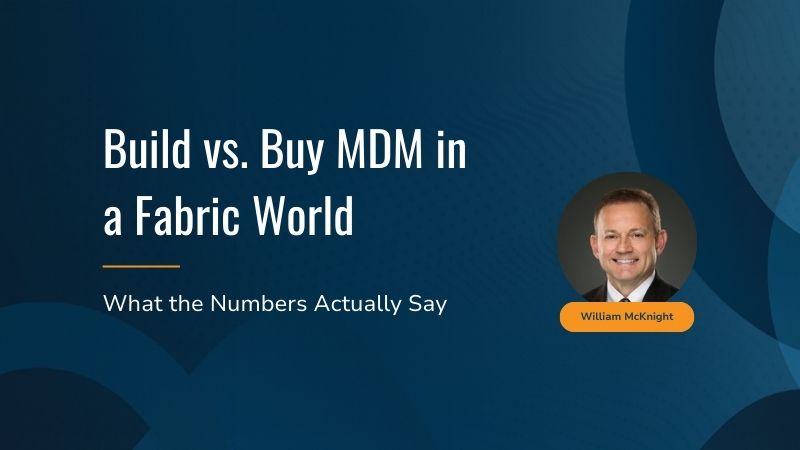In my time as a Gartner analyst covering master data management (MDM) and two years advising clients and prospects at a leading vendor, I have seen several issues derail a well-intentioned implementation.
For organizations considering implementing MDM, here are three critical success factors that I have found in several successful implementations.
1. Frame Your Master Data Management Implementation with Business Goals in Mind
The key to any successful MDM implementation is letting business goals drive an implementation rather than starting from an IT-based perspective. Rather than another variable cost project for the company, MDM should be considered a revenue-boosting and optimizing endeavor that will drive significant business value and prove ROI.
The goals of an MDM implementation should not differ from the goals of the business, whether those include generating incremental revenue through cross-sell opportunities to reducing inventory costs by having accurate insight into the supply chain.
While implementing MDM is an inherently technological endeavor, the end goal should never be to simply connect source systems or consolidate records — organizations must tie these tactics to the higher-order outcome to successfully gain stakeholder engagement and measure the success of their efforts.
A narrow, data-centric view can have a devastating impact at the foundational level of any MDM implementation — yet this IT-driven framework is often still the default approach most enterprises take to implementing MDM until they receive the guidance needed to avoid this doomed-to-fail approach.
2. Do Not Fall into the Single Domain Mindset
Just as organizations can fall into a technology- or IT-centric mindset when planning for an MDM implementation, it is also common for them to set their eyes on a single type, or domain of data.
I have heard several implementers describe their initial thinking as, “We need to master all of our customer data.”
They search for an MDM solution that is either built out-of-the-box for the customer master data domain (for example), or a multidomain MDM platform that will allow them to construct a data model for the customer domain as they see fit.
Unfortunately, this usually results in a data model that encompasses every master data entity and attribute that the IT organization can identify as customer data.
There are admittedly some rare cases where trusted customer master data on its own can provide some level of value. However, interacting with thousands of implementers over the past decade — as well as managing several successful MDM and data governance implementations myself — has shown me that these scenarios are exceedingly rare.
In cases where the acquired software is licensed solely for a single domain, this inability to provide early business value is aggravated even further and can result in the program struggling at the foundational level, or even failing outright.
3. Be Flexible in Your Approach to Multidomain Master Data Management
Instead of thinking of multidomain MDM as the serial, or even concurrent, implementation of two or more master data domains, multidomain should be taken to mean the freedom and flexibility to model only those master data entities and attributes that contribute to the agreed-upon business outcomes — regardless of the data domains to which they belong.
For example, the default approach would be to identify all 100 data attributes that can be considered customer master data in an organization and then licensing a solution to master only those attributes — only to realize that to deliver value, the program would also need to master 25 of the 200 product master data attributes required for a 360-degree view of the enterprise’s customers.
If a software solution only deals with the customer domain — or it is a multidomain platform that requires a separate license for each data domain in scope — it will not only delay the implementation but will result in a significant increase in license costs.
Of course, this best-practice approach only makes sense if the acquired MDM solution is a data-model-agnostic platform, and that the vendor does not license each domain separately.
This approach, coupled with a robust and ratified business case and/or road map that the MDM vendor should help create, can virtually eliminate the risk of program failure while confining the overall scope to deliver value as early as possible.
Only then can the program be increased incrementally as business needs are identified, without worrying about the simple crossing of data domain boundary lines causing an increase in software costs going forward.
This is just an introduction to how mastering multiple domains contributes to the success of MDM implementations. To learn more, read how various data domains impact digital transformation.
Bill O’Kane, VP and MDM Strategist at Profisee
With over twenty years of experience in the design, development, and implementation of large-scale Data Governance and Master Data Management (MDM) programs and systems, Bill O’Kane is VP and MDM Strategist at Profisee, a leader in Master Data Management (MDM) solutions. Bill served for eight years as Vice President of Data and Analytics and Magic Quadrant lead author at Gartner. He is a recognized thought leader and the world’s foremost authority on the topics of Information Governance and MDM program management, vendors and technologies, and MDM’s role within an overall enterprise information management strategy.

Bill O'Kane
A former Gartner analyst, Bill O'Kane was the VP & MDM Strategist at Profisee.











